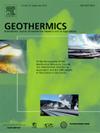地热勘探中含地形的大地电磁资料三维有限元与有限差分反演的可靠性——以大流津地热田为例
IF 3.5
2区 工程技术
Q3 ENERGY & FUELS
引用次数: 0
摘要
为了研究地热勘探中大地电磁(MT)数据的三维(3D)反演性能(精确的数值模拟对于处理粗糙地形至关重要),我们使用了两个反演代码(FEMTIC和WSINV3DMT)对日本北部大流zu地热区获得的大地电磁(MT)数据进行了三维反演。FEMTIC是一种有限元反演代码。它可以结合四面体单元(Tetra)或变形不协调六面体单元(DHexa)来构建三维网格。同时,WSINV3DMT是一种有限差分(FDM)反演码。它使用矩形单元来离散三维域。我们准备了相同的MT数据子集,并设置了相同的噪声底,以运行Tetra、DHexa和WSINV3DMT反演。这三次反演得到了相似的3D模型。显示了该区盖层和地热储层的电阻率异常。然而,在模型细节方面存在一些显著的差异,特别是在FEMTIC和WSINV3DMT倒温之间。在野外数据反演结果的基础上,对DHexa和WSINV3DMT进行了三维合成数据的数值实验,探讨了造成这些差异的因素。我们在具有真实地形的均匀大地中设置了两个低电阻率异常(浅层和深层)。实验表明,hexa反演有效地恢复了这两个异常。然而,WSINV3DMT反演可能无法恢复这些。特别是,当我们在模型中加入粗糙地形变化时,由于数值误差,深层异常重建效果不佳。因此,我们认为使用FDM代码的野外数据反演结果对于在崎岖地形环境中获得的MT数据集可能存在不可靠的异常。Tetra和DHexa对大会足地区的野外资料进行了反演,结果与现有的测井资料和该地区的地热概念模型吻合较好。本文章由计算机程序翻译,如有差异,请以英文原文为准。
Reliability of 3D finite-element and finite-difference inversion of magnetotelluric data including topography for geothermal exploration: Case study in Okuaizu geothermal field
To investigate the performance of the three-dimensional (3D) inversion of magnetotelluric (MT) data for geothermal exploration (where accurate numerical modeling is essential for addressing rough topographies), we utilized two inversion codes (FEMTIC and WSINV3DMT) for the 3D inversion of MT data obtained from the Okuaizu geothermal area, northern Japan. FEMTIC is a finite-element (FEM) inversion code. It can incorporate tetrahedral elements (Tetra) or deformed nonconforming hexahedral elements (DHexa) to construct a 3D mesh. Meanwhile, WSINV3DMT is a finite-difference (FDM) inversion code. It uses rectangular cells to discretize the 3D domain. We prepared an identical subset of the MT data and set an identical noise floor to run the Tetra, DHexa, and WSINV3DMT inversions. The three inversions yielded similar 3D models. These displayed resistivity anomalies related to the cap rock and geothermal reservoir in the area. However, there are several significant differences in the model details, particularly between the FEMTIC and WSINV3DMT inversions. Numerical experiments on 3D synthetic data based on the inversion results of the field data were then conducted for DHexa and WSINV3DMT to examine the factors causing these differences. We set two low-resistivity anomalies (shallow and deep) embedded in a homogeneous earth with real topography. The experiments revealed that the DHexa inversion effectively recovered the two anomalies. However, the WSINV3DMT inversion may have failed to recover these. In particular, the deep anomaly was reconstructed ineffectively owing to numerical errors when we included a rough topographic variation in the model. Therefore, we considered that the inversion results of field data using an FDM code may have unreliable anomalies for an MT dataset obtained in a rough terrain environment. The inverted models of the field data in Okuaizu by Tetra and DHexa showed good agreement with existing borehole logging data and the geothermal conceptual model of the area.
求助全文
通过发布文献求助,成功后即可免费获取论文全文。
去求助
来源期刊

Geothermics
工程技术-地球科学综合
CiteScore
7.70
自引率
15.40%
发文量
237
审稿时长
4.5 months
期刊介绍:
Geothermics is an international journal devoted to the research and development of geothermal energy. The International Board of Editors of Geothermics, which comprises specialists in the various aspects of geothermal resources, exploration and development, guarantees the balanced, comprehensive view of scientific and technological developments in this promising energy field.
It promulgates the state of the art and science of geothermal energy, its exploration and exploitation through a regular exchange of information from all parts of the world. The journal publishes articles dealing with the theory, exploration techniques and all aspects of the utilization of geothermal resources. Geothermics serves as the scientific house, or exchange medium, through which the growing community of geothermal specialists can provide and receive information.
 求助内容:
求助内容: 应助结果提醒方式:
应助结果提醒方式:


